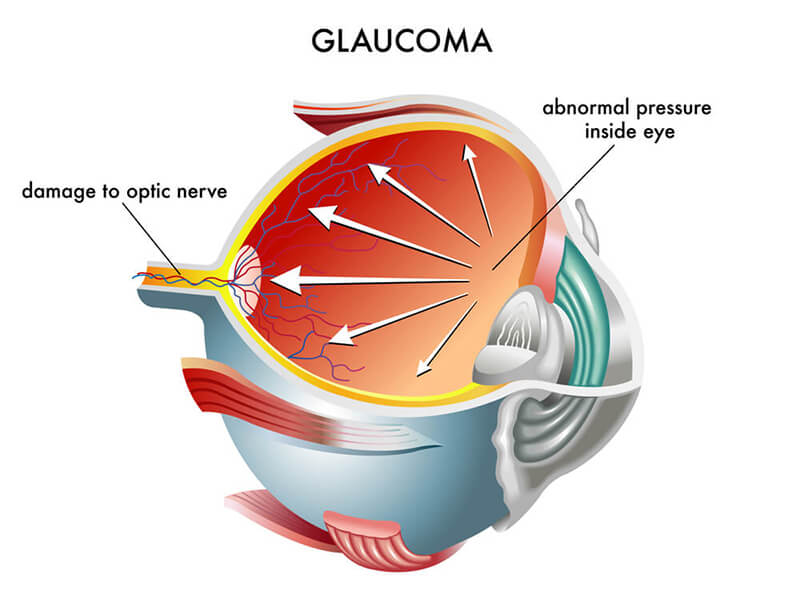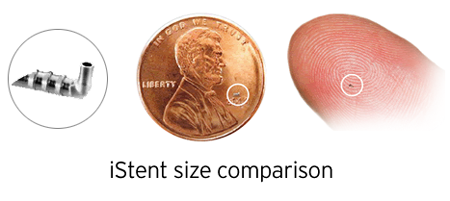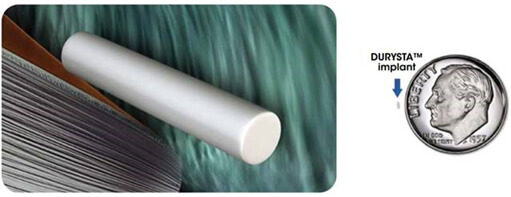Glaucoma Management at The Pankratz Eye Institute
Despite recent breakthroughs in our ability to diagnose and treat glaucoma, it remains the leading cause of irreversible blindness throughout the world. Doctors refer to glaucoma as the “silent thief of sight” as patients are often unaware they have the disease since they lose their peripheral (outside) vision first and don’t seek care until they have advanced glaucoma. That is why we encourage patients to get annual checkups, especially if you have a family history of glaucoma or are among the groups with high risk factors for glaucoma, which includes African Americans. In fact, about 2 out of every 100 adults have or will develop glaucoma. And because there are no early warning signs, over 3 million American have glaucoma…but less than half are aware of it.
What is Glaucoma?
Glaucoma is a very common disease that damages the optic nerve that connects the back of your eye to the brain. It normally occurs as a result of high pressure in the eye (eye pressure, not blood pressure). Typically, as your eye pressure rises, the optic nerve gets damaged, often causing permanent vision loss. Patients will slowly lose their peripheral vision initially. If treatment is not started, the disease can eventually cause more and more vision loss…which can lead to permanent blindness. In most cases, there is no pain as the vision loss occurs, which again leads patients NOT to seek treatment.

Significant Risk Factors for Glaucoma
- African American (4 times more likely than others to have the disease)
- Family history of glaucoma (a first degree relative with glaucoma)
- Age (older patients are at higher risk of developing the disease)
- History of high eye pressure
Types of Glaucoma
Primary Open Angle Glaucoma: This is the most common type of glaucoma in the United States. It occurs when the portion of the eye that serves as a natural drain becomes damaged. This is can lead to a gradual increase in the eye pressure and subsequent damage to the optic nerve (and loss of vision).
Angle Closure Glaucoma: This is when the front portion of the eye is too crowded and the drain of the eye gets blocked by the pigmented iris. This can result in a sudden elevation of pressure to the eye (acute angle closure glaucoma) or slowly develop as scar tissue forms over the drain of the eye (chronic angle closure glaucoma). In acute angle closure glaucoma, patients can experience sudden pain in the eye and rapid vision loss and is a medical emergency. This is usually treated by a small laser known as laser peripheral iridotomy.
Besides these two main types of glaucoma, there are many other less common types. Injury and prior eye surgery can result in glaucoma as well. Some types of glaucoma include:
- Pigment Dispersion glaucoma
- Pseudoexfoliation glaucoma
- Congenital and Juvenile glaucoma
- Steroid Induced glaucoma
- Angle Recession glaucoma
- Inflammatory/Uveitic glaucoma
Glaucoma Treatment
At the Pankratz Eye Institute, we offer the latest treatment modalities and surgical techniques in the management of glaucoma. Glaucoma management typically consists of one of three treatment types: glaucoma drops; glaucoma laser treatment; glaucoma surgery. Based on a thorough evaluation of your ocular system, an appropriate treatment regimen will be recommended by one of our surgeons.
Eye Drops
There are multiple types of eye drops used to treat glaucoma by lowering the pressure in your eyes. After a thorough evaluation, one of our doctors will make a proper recommendation to you about which is recommended should you need them. Most of the drops either reduce the production of the watery fluid in the eye (called aqueous) or help improve the flow of aqueous out of the eye.
Eye Drop Classes:
- Prostaglandins (Xalatan, Travatan, Lumigan, Vyzulta)
- Beta Blockers (Timolol)
- Alpha Agonists (Alphagan)
- Carbonic Anhydrase Inhibitors (Azopt, Trusopt)
- Rho Kinase Inhibitors (Rhopressa, Rocklatan)
SLT Laser
Based on your condition, one of our doctors may suggest a laser treatment known as SLT (selective laser trabeculoplasty). SLT laser treatments targets the drainage portion of the eye to help improve the flow of fluid out of the eye, thus reducing the pressure. This is a quick, safe technique to achieve pressure reduction. The procedure only takes about 5 minutes and is painless.
Surgery
Traditional glaucoma surgery is typically reserved for more severe cases of glaucoma and involves creation of an artificial drainage pathway in the eye.
There are also now additional “minimally invasive” glaucoma surgeries that are performed by our surgeons to help relieve the ocular pressure built up by glaucoma. Some of these procedures are reserved for patients with milder glaucoma and can only be used at the time of cataract surgery, while others may be used in more advanced situations with or without cataract surgery. Our surgeons can make recommendations to you should they recommend one of these procedures.
iStent Trabecular Micro-Bypass
New Technology for the Treatment of Open-Angle Glaucoma During Cataract Surgery.
Making treating your glaucoma a part of treating your cataract surgery procedure.
Technology has always played an important role in eye care. Today, almost every aspect of vision is connected to a product or procedure that wasn’t available even 10 short years ago. If you have glaucoma and also require cataract surgery there is a new glaucoma eye care procedure that can help. By utilizing the iStent® our doctors can better help cataract patients with glaucoma. The iStent® enables patients to use fewer eye drops for their glaucoma treatment and possibly eliminate the need to use prescription eye drops at all.

The iStent® is FDA-approved for use in conjunction with cataract surgery to reduce eye pressure in adult patients with mild-to moderate open-angle glaucoma currently being treated with glaucoma medicine. In clinical trials, iStent® has been shown to safely reduce eye pressure, which is the primary cause of open-angle glaucoma.
How The iStent® Trabecular Micro-Bypass Works?
High levels of intraocular pressure ”IOP” (fluid within the eye) is the only controllable factor when treating glaucoma and is the number one risk factor for glaucoma. The main cause of elevated eye pressure in patients with primary open-angle glaucoma is a reduction of the aqueous outflow in an area called the trabecular meshwork. For patients with combined cataract and open-angle glaucoma, iStent reduces introcular pressure (IOP) by improving aqueous humor outflow.
DURYSTA
Open-angle glaucoma, the most common form of the chronic disease, comprises 90% of cases. Fluid builds up in the front of the eye causing increased pressure which ultimately damages the optic nerve, responsible for transmitting images to the brain

This type of glaucoma is often painless but can cause severe vision loss and blindness if not treated. The most common therapy for open-angle glaucoma is prostaglandin eye drops. Unfortunately, up to 80% of patients don’t use eye drops as prescribed.
“The biggest hurdles for glaucoma compliance are patients forgetting to use daily eye drops, not getting the drops in correctly, and not being able to afford the drops. The results of poor compliance can be blindness, not something we want to risk!”
DURYSTA is the first and only FDA-approved, biodegradable, intracameral implant indicated to reduce intraocular pressure (IOP) in patients with open angle glaucoma (OAG) or ocular hypertension (OHT) via a sustained-release drug delivery system.
DURYSTA is believed to lower IOP in humans by increasing the outflow of aqueous humor through both the trabecular meshwork (conventional) and uveoscleral routes (unconventional). It is preloaded into a single-use, Direct Delivery System applicator to facilitate injection of the small implant directly into the anterior chamber of the eye.



